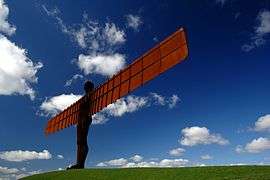List of public art in Liverpool
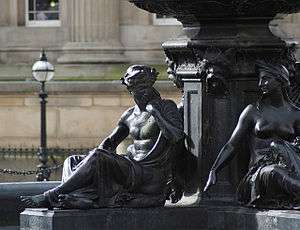
The city of Liverpool has a greater number of public sculptures than any other location in the United Kingdom aside from Westminster.[1] Early examples include works by George Frampton, Goscombe John, Thomas Thornycroft, Charles Bell Birch, Richard Westmacott, Francis Chantrey, John Gibson, Thomas Brock and F.W. Pomeroy, while Barbara Hepworth, Jacob Epstein, Mitzi Cunliffe and Elizabeth Frink provide some of the modern offerings. More recently, local artist Tom Murphy has created a dozen sculptures in Liverpool.
While statues and sculpture are dotted throughout the inner city, there are four primary groupings: inside and around St George's Hall; in St John's Gardens;[2] around the Pier Head; and around the Palm House at Sefton Park. Smaller groups are found in Old Hall Street/Exchange Flags and in and around The Oratory.
The Queen Victoria Monument at Derby Square, an ensemble of 26 bronze figures by C. J. Allen, is described in the Liverpool Pevsner Architectural Guide as one of the most ambitious British monuments to the Queen.[3]
NB: the following list does not include the comprehensive collections held by National Museums Liverpool, or the countless ornate features of many Liverpool buildings.
Royalty
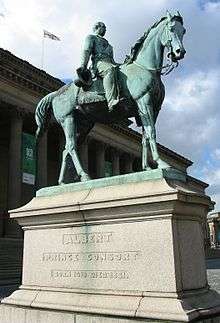
- George III bronze equestrian by Richard Westmacott (1822), at Monument Place, London Road (Grade II)
- Queen Victoria bronze equestrian by Thomas Thornycroft (1869), outside St. George's Hall (Grade II)
- Queen Victoria bronze by C. J. Allen (1906) on the Victoria Monument in Derby Square (Grade II)
- Prince Albert bronze equestrian by Thomas Thornycroft (1866), outside St. George's Hall (Grade II)
- Edward VII bronze equestrian by Goscombe John (1916), at the Pier Head (Grade II)
- George V bronze by Goscombe John (1939), at the Queensway Tunnel entrance
- Queen Mary bronze by Goscombe John (1939), at the Queensway Tunnel entrance
Statesmen and Politicians
- William Huskisson bronze by John Gibson (1847), in Dukes Terrace car-park off Duke Street (Grade II); there is also the original (1831) marble version by the same artist inside The Oratory, which originally stood inside the Huskisson Memorial (1831) (Grade II) in nearby St James's Cemetery [4]
- George Canning marble by Francis Chantrey (1832) inside Liverpool Town Hall
- William Ewart marble by Joseph Gott (1832), inside The Oratory
- Robert Peel marble by Matthew Noble (1853), inside St. George's Hall
- Gladstone marble by John Adams-Acton (1868), inside St. George's Hall
- Edward Smith-Stanley, 14th Earl of Derby marble by William Theed (1869), inside St. George's Hall
- Edward Whitley marble by Albert Bruce Joy (1895), inside St. George's Hall
- Gladstone bronze by Thomas Brock (1904), in St. John's Gardens (Grade II)
- Disraeli bronze by Charles Bell Birch (1883), outside St. George's Hall (Grade II)
- Samuel Robert Graves marble by Giovanni Fontana (1875), inside St. George's Hall
- Arthur Bower Forwood bronze by George Frampton (1903), in St. John's Gardens (Grade II)
- Frederick Stanley, 16th Earl of Derby marble by F. W. Pomeroy (1911), inside St. George's Hall
- Bessie Braddock bronze by Tom Murphy (2009) at Lime Street station
Military
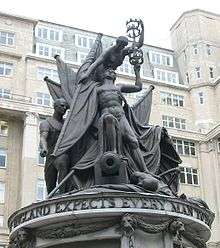
- Nelson bronze by Matthew Cotes Wyatt and Richard Westmacott (1813), at Exchange Flags (Grade II*)
- Wellington bronze by G. A. Lawson (1863), on a column outside St. George's Hall (Grade II*)
- William Earle bronze by Charles Bell Birch (1887), outside St. George's Hall (Grade II)
- Noel Chavasse VC* bronze by Tom Murphy (2008), in Abercromby Square
- Johnnie Walker DSO*** bronze by Tom Murphy (1998), at the Pier Head
Business and Inventors
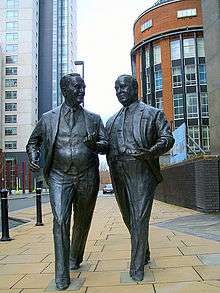
- André Le Nôtre marble by Léon-Joseph Chavalliaud (1899), in Sefton Park
- George Stephenson marble by John Gibson (1851), inside St. George's Hall
- William Mackenzie monument granite pyramid by unknown (1868), in St. Andrew's Churchyard, Rodney Street (Grade II)
- Henry Booth marble by William Theed (1874), inside the northern entrance to St. George's Hall
- John and Cecil Moores bronze by Tom Murphy (1996), on Church Street; another single bronze (1998) of John Moores off Tithebarn Street by the same artist.
Sports
- Bill Shankly bronze by Tom Murphy (1997), outside Liverpool Football Club
- Dixie Dean bronze by Tom Murphy (2001), outside Everton Football Club
Entertainers
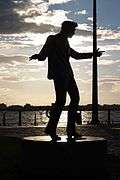
- John Lennon bronze by Tom Murphy (2002), at Liverpool Airport; there are several other statues to Lennon around Liverpool, for example in Mathew Street[5] and above the Beatles' Hotel.
- Billy Fury bronze by Tom Murphy (2003), at the Pier Head
- Ken Dodd bronze by Tom Murphy (2009), at Lime Street station
- The Beatles on the Pier Head, unveiled December 2015 to commemorate 50 years since their last performance in the city.
Religious Figures
- Kneeling Madonna wood by Giovanni della Robbia (15th century), inside the Anglican Cathedral
- Holy Family marble by Josefina de Vasconcellos, inside the Anglican Cathedral
- Christ on a Donkey fibreglass and metal by Brian Burgess (1972)[6]
- Our Lady of the Quays bronze by Arthur Dooley, inside "The Sailors Church", Pier Head
- Abraham bronze by Sean Rice (1991), inside Liverpool Metropolitan Cathedral
- The Risen Christ bronze by Elizabeth Frink (1993), outside the Anglican Cathedral
- Christ Risen bronze by Arthur Dooley, inside the Metropolitan Cathedral
- Madonna bronze by Arthur Dooley, inside the Gustav Adolf Church
- Christ bronze by Arthur Dooley, inside the Gustav Adolf Church
Philanthropists and Clergy

- William Roscoe marble by Francis Chantrey (1841), inside St. George's Hall
- Jonathan Brooks marble by Benjamin Edward Spence (1858), inside St. George's Hall
- Kitty Wilkinson marble by Simon Smith (2012), inside St. George's Hall[7]
- Sir William Brown marble by Patrick MacDowell (1860), inside St. George's Hall
- Agnes Jones marble by Pietro Tenerani (1868) inside The Oratory
- William Rathbone marble by J. H. Foley and Thomas Brock (1877) in Sefton Park (Grade II)
- William Rathbone (son of above) bronze by George Frampton (1901), in St. John's Gardens (Grade II)
- Hugh Boyd M‘Neile marble by George Gamon Adams (1870), inside St. George's Hall
- Joseph Mayer marble by Giovanni Fontana (1869), inside St. George's Hall
- Alexander Balfour bronze by Albert Bruce Joy (1889), in St. John's Gardens (Grade II)
- James Nugent bronze by F. W. Pomeroy (1906), in St. John's Gardens (Grade II)
- Thomas Lester bronze by George Frampton (1907), in St. John's Gardens (Grade II)
- Derek Worlock bronze by Stephen Broadbent (2008), on Hope Street
- David Sheppard bronze by Stephen Broadbent (2008), on Hope Street
Scientists and Philosophers
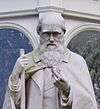
- John Parkinson marble by Léon-Joseph Chavalliaud (1899), in Sefton Park
- Carl Linnaeus marble by Léon-Joseph Chavalliaud (1899), in Sefton Park
- Charles Darwin marble by Léon-Joseph Chavalliaud (1898), in Sefton Park
- Sir Oliver Lodge bronze by C. J. Allen (1906), one of a group of figures entitled Education at the base of the Victoria Monument in Derby Square.
- Jung bronze by Johnathon Drabkin (1993) on Mathew Street
Explorers and Geographers
.jpg)
- Henry the Navigator bronze by Léon-Joseph Chavalliaud (1898), in Sefton Park
- Mercator bronze by Léon-Joseph Chavalliaud (1898), in Sefton Park
- Columbus bronze by Léon-Joseph Chavalliaud (1898), in Sefton Park
- Captain Cook bronze by Léon-Joseph Chavalliaud (1898), in Sefton Park
- Amy Johnson Portland stone by Edmund Thompson (1934); figure entitled Speed on the George's Dock ventilation and control station, Pier Head (Grade II)
Artists
- Michelangelo marble by John Warrington Wood (1877), outside the Walker Art Gallery (badly weathered)
- Raphael marble by John Warrington Wood (1877), outside the Walker Art Gallery (badly weathered)
Educationists
- Henry Egerton Cotton bronze by Tom Murphy (1998), at John Moores University, Trueman Street
Fictional, Poetical and Allegorical Characters
- Minerva terracotta by John Charles Felix Rossi (1802), above Liverpool Town Hall[8]
- Highland Mary marble by Benjamin Spence (1850) inside the Palm House at Sefton Park
- The Angel's Whisper marble by Benjamin Spence (1857) inside the Palm House at Sefton Park
- Spirit of Liverpool marble by John Warrington Wood (1877), on the roof of the Walker Art Gallery[9]
- Neptune, Amphitrite, Acis and Galatea bronze figures by Paul Liénard (1879) on the Steble Fountain outside St. George's Hall (Grade II*)
- Justice and Truth bronze by Thomas Brock (1904) on the Gladstone memorial in St. John's Gardens (Grade II)
- Britannia bronze by Goscombe John (1905) on The King's Regiment memorial in St. John's Gardens (Grade II)
- Navigation, Commerce and The River Mersey Portland stone by William Birnie Rhind and E. O. Griffith (1906), inside and outside the Cotton Exchange, Old Hall Street (badly weathered)[10]
- Justice, Wisdom, Charity, Peace, Education, Industry, Commerce, Agriculture and Fame bronze by C. J. Allen (1906) on the Queen Victoria Monument, Derby Square (Grade II)
- Liver Birds bronze by Carl Bernard Bartels (1911) on the towers of the Royal Liver Building
- Liverpool, Research and The Fruits of Industry bronze female figures by George Frampton (1913) on the memorial to Alfred Lewis Jones at the Pier Head (Grade II)
- Victory bronze by Henry Alfred Pegram (1921), at the Pier Head (Grade II)
- Peter Pan bronze by George Frampton (1928), in Sefton Park (Grade II)
- Eros aluminium by Alfred Gilbert (1932), in Sefton Park[11] (Grade II)
- Night & Day black basalt by Edmund Thompson (1934) on the George's Dock ventilation and control station, George's Dockway
- Liverpool Resurgent bronze by Jacob Epstein (1956), outside the former Lewis's department store
- Eleanor Rigby bronze by Tommy Steele (1982), in Stanley Street
- Superlambanana concrete and fibreglass by Taro Chiezo and local artists (1998), in Tithebarn Street; numerous replicas are dotted throughout the city
- Mother and Child bronze by Terry McDonald (1999), outside the Liverpool Women's Hospital, Crown Street
- Sea Trek bronze by Mark DeGraffenried (2001), looking out to sea, near the Albert Dock
Animals
- Two Goats marble by Giovita Lombardi (c.1867) inside the Palm House at Sefton Park
- Four Recumbent Lions stone by William Grinsell Nicholl (1855) outside St. George's Hall (Grade II)
- Red Rum bronze equine by Philip Blacker (1987) at Aintree Racecourse
- Temple lions or fu-dogs (3 pairs) bronze by Mr. Zhang of Shanghai (2000) on Berry, Nelson and Great George Streets
- The Great Escape bronze equine by Edward Cronshaw (2000), Canning Place, next to Merseyside Police Headquarters
- The Roman Standard bronze of a bird on a staff by Tracey Emin (2005) outside The Oratory[12]
- Waiting bronze equine by Judy Boyt (2010) outside the Museum of Liverpool
War Memorials
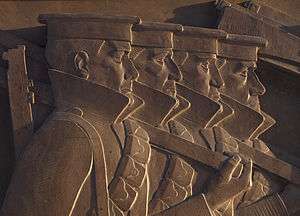
- The King's Regiment memorial granite and bronze by Goscombe John (1905), in St. John's Gardens[13] (Grade II)
- "Titanic" memorial granite by Goscombe John (1916) at the Pier Head[14] (Grade II*)
- Cunard War Memorial stone and bronze by Arthur Davis and Henry Alfred Pegram (1921), at the Pier Head[15] (Grade II)
- Cotton Exchange memorial bronze by Francis Derwent Wood (1922), inside the Cotton Exchange, Old Hall Street
- Exchange Newsroom memorial bronze by Joseph Phillips (1924), at Exchange Flags
- Post Office memorial limestone by Herbert Tyson Smith (1924), at Metquarter in Victoria Street
- Liverpool Cenotaph stone and bronze by Lionel Bailey Budden and Herbert Tyson Smith (1930), outside St. George's Hall[16] (Grade I)
- Merchant Navy memorial Portland stone by Herbert Tyson Smith (1952), at the Pier Head (Grade II)
- Liverpool Blitz memorial bronze by Tom Murphy (2000), in the Sailors' Church garden, Pier Head
Abstract Sculpture

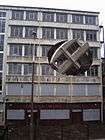
- The Quickening stone by Mitzi Cunliffe (1951), at rear of Civic Design Building, Liverpool University
- Three Uprights aluminium by Hubert Dalwood (1959) at the University Extension, Chatham Street
- Seven Seas metal by Stanley English (1966), at the Pier Head
- Squares with Two Circles bronze and concrete by Barbara Hepworth (1969) at Abercromby Square
- Cormorants Diving metal by Sean Rice (1972), inside the Atlantic Tower Hotel
- Seagulls Rising metal by Sean Rice (1972), courtyard of the Atlantic Tower Hotel
- Red Between steel by Phillip King (1973) in the quadrangle of the Victoria Gallery & Museum, Liverpool University[17]
- Palanzana stone by Stephen Cox (1984), on Byrom Street
- Tango metal by Allen Jones (1984) at Concert Square
- Sea Circle bronze by Charlotte Mayer (1984) on Seymour Street
- Raleigh stone and metal by Tony Cragg (1986), outside the Tate Liverpool, Albert Dock
- Reconciliation metal by Stephen Broadbent (1990), in Concert Street
- Ray + Julie metal by Alan Dunn and Brigitte Jurack (1995), on a vacant site in London Road
- A Case History stone by John King (1998), on Hope Street
- The Seed metal by Stephen Broadbent (2002), in Campbell Street
- Connections steel, concrete, timber, glass by Stephen Broadbent (2004), outside Beetham Tower, Old Hall Street
- Penelope metal by Jorge Pardo (2006), in Wolstenholme Square
- Skyline metal by Oliver Barratt (2007) at New Quay
- Turning the Place Over mobile ovoid segment of a disused building by Richard Wilson (2007) in Moorfields[18]
- Peace & Harmony metal and glass by Lauren Voiers (2010), at Kings Dock
- Irish Famine Memorial, granite and bronze in St Luke's Gardens, Leece Street.
See also
Gallery
-
Gladstone inside St. George's Hall
-

John Lennon on Mathew Street
-
Johnnie Walker DSO*** at the Pier Head
-
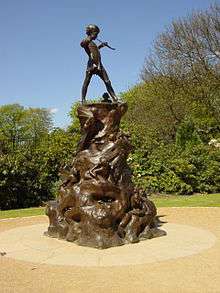
Peter Pan in Sefton Park
-
.jpg)
William Earle outside St. George's Hall
-

Liverpool Resurgent outside Lewis's store
-

George V at the Mersey Tunnel entrance
-

Eleanor Rigby on Stanley Street
-
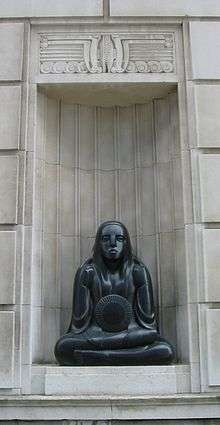
Day outside the George's Dock Control Station
-
William Roscoe inside St. George's Hall
-

Christ Risen at the Anglican Cathedral
-

John Lennon at Liverpool Airport
-
Queen Victoria outside St. George's Hall
-

Ken Dodd at Lime Street station
-

Gladstone (and figure of Justice) in St. John's Gardens
-

Archbishop Derek Worlock on Hope Street
-
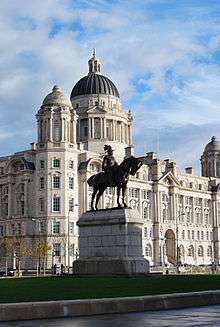
Edward VII at the Pier Head
-

Arthur Bower Forwood in St. John's Gardens
-

Raphael outside the Walker Art Gallery
-

Michelangelo outside the Walker Art Gallery
-

Noel Chavasse VC* at Abercromby Square
-

George III on London Road
-

King's Liverpool memorial (including figure of Britannia) in St. John's Gardens
-

George Canning at Liverpool Town Hall
-

Bessie Braddock at Lime Street station
-

Alexander Balfour in St. John's Gardens
-

Mother and Child at the Women's Hospital
-

Detail of Sir Oliver Lodge, on the Queen Victoria Monument
-
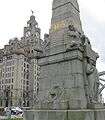
Titanic memorial, Pier Head
-

Eros in Sefton Park
-
.jpg)
The River Mersey on Old Hall Street
-
.jpg)
Henry the Navigator in Sefton Park
-

figures of Liverpool and The Fruits of Industry, on the Alfred Lewis Jones memorial
-
Thomas Major Lester in St. John's Gardens
-

William Rathbone in Sefton Park
-
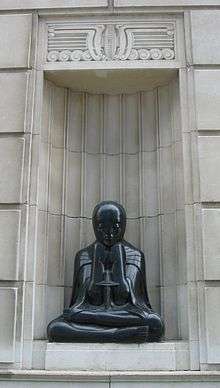
Night outside the George's Dock Control Station
-
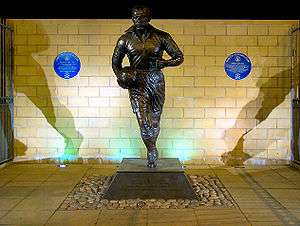
Dixie Dean outside Everton Football Club
-
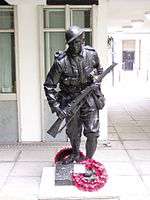
War Memorial at the Cotton Exchange
-

Lions at St. George's Plateau
-
Mackenzie monument, Rodney Street
-

A Case History, Hope Street
References
- ↑ "Historic Britain: Liverpool". HistoricBritain.com. Retrieved 2009-07-13.
- ↑ dubbed "Liverpool's alfresco Valhalla", every statue inside is listed, together with the walls and gatepiers
- ↑ Sharples, Joseph; Pollard, Richard (2004). Liverpool. New Haven: Yale University Press. p. 149. ISBN 978-0300102581. Retrieved February 4, 2013.
- ↑ an 1836 copy of the original marble now stands in Pimlico Gardens, London. The Liverpool bronze was in turn copied from this
- ↑ e.g. Four Lads who shook the World by Arthur Dooley (1974)
- ↑ sited for many years outside the Sailors' Church, Pier Head, this interesting equestrian suffered damage and its whereabouts are currently unknown, presumed lost
- ↑ The first statue to be placed in St. George's Hall in over 100 years, and the first depicting a woman. There are several vacant plinths remaining.
- ↑ debate still over whether the figure actually represents Britannia
- ↑ the original was removed in 1993 to the Conservation Centre, and a copy hewn from a 41-ton block of Chinese marble
- ↑ these colossal sculptures had originally adorned the roof
- ↑ a modern copy; the original bronze is on display at the Conservation Centre
- ↑ the work has been stolen and returned at least twice
- ↑ commemorates 19th Century wars in Afghanistan, Burma and South Africa
- ↑ originally intended to commemorate the Titanic engineers, its dedication was broadened to include all marine engineers killed in the First World War
- ↑ incorporating the Spirit of Victory mentioned above
- ↑ described by Sharples and Pollard as "one of the most remarkable war memorials in the country"
- ↑ Liverpool University
- ↑ the motor was switched off in 2011
- Bibliography
- Pollard, Richard; Pevsner, Nikolaus (2006), Lancashire: Liverpool and the South-West, The Buildings of England, New Haven and London: Yale University Press, ISBN 0-300-10910-5
External links
- Liverpool Monuments website of Friends of Liverpool Monuments Civic Society
- Victorian City Centre: Liverpool Public Art Research Archive, Sheffield Hallam University
- Liverpool Architecture and Cityscapes The Victorian Web
- Art in Liverpool website of Bob Speel
- Pure sensory overload in Liverpool Modern Masters, BBC

